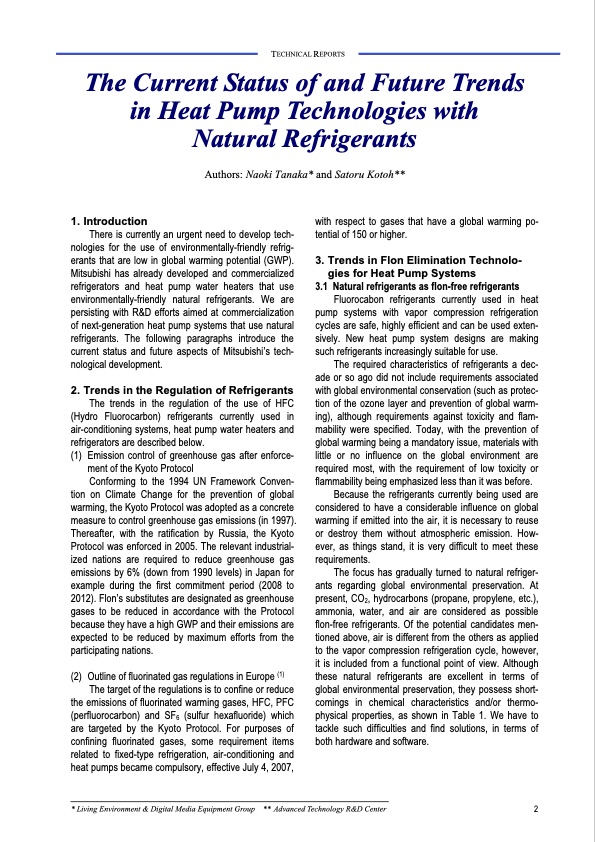
PDF Publication Title:
Text from PDF Page: 004
TECHNICAL REPORTS The Current Status of and Future Trends in Heat Pump Technologies with Natural Refrigerants 1. Introduction Authors: Naoki Tanaka* and Satoru Kotoh** with respect to gases that have a global warming po- There is currently an urgent need to develop tech- nologies for the use of environmentally-friendly refrig- erants that are low in global warming potential (GWP). Mitsubishi has already developed and commercialized refrigerators and heat pump water heaters that use environmentally-friendly natural refrigerants. We are persisting with R&D efforts aimed at commercialization of next-generation heat pump systems that use natural refrigerants. The following paragraphs introduce the current status and future aspects of Mitsubishi’s tech- nological development. 2. Trends in the Regulation of Refrigerants The trends in the regulation of the use of HFC (Hydro Fluorocarbon) refrigerants currently used in air-conditioning systems, heat pump water heaters and refrigerators are described below. (1) Emission control of greenhouse gas after enforce- ment of the Kyoto Protocol Conforming to the 1994 UN Framework Conven- tion on Climate Change for the prevention of global warming, the Kyoto Protocol was adopted as a concrete measure to control greenhouse gas emissions (in 1997). Thereafter, with the ratification by Russia, the Kyoto Protocol was enforced in 2005. The relevant industrial- ized nations are required to reduce greenhouse gas emissions by 6% (down from 1990 levels) in Japan for example during the first commitment period (2008 to 2012). Flon’s substitutes are designated as greenhouse gases to be reduced in accordance with the Protocol because they have a high GWP and their emissions are expected to be reduced by maximum efforts from the participating nations. (2) OutlineoffluorinatedgasregulationsinEurope(1) The target of the regulations is to confine or reduce the emissions of fluorinated warming gases, HFC, PFC (perfluorocarbon) and SF6 (sulfur hexafluoride) which are targeted by the Kyoto Protocol. For purposes of confining fluorinated gases, some requirement items related to fixed-type refrigeration, air-conditioning and heat pumps became compulsory, effective July 4, 2007, tential of 150 or higher. 3. Trends in Flon Elimination Technolo- gies for Heat Pump Systems 3.1 Natural refrigerants as flon-free refrigerants Fluorocabon refrigerants currently used in heat pump systems with vapor compression refrigeration cycles are safe, highly efficient and can be used exten- sively. New heat pump system designs are making such refrigerants increasingly suitable for use. The required characteristics of refrigerants a dec- ade or so ago did not include requirements associated with global environmental conservation (such as protec- tion of the ozone layer and prevention of global warm- ing), although requirements against toxicity and flam- mability were specified. Today, with the prevention of global warming being a mandatory issue, materials with little or no influence on the global environment are required most, with the requirement of low toxicity or flammability being emphasized less than it was before. Because the refrigerants currently being used are considered to have a considerable influence on global warming if emitted into the air, it is necessary to reuse or destroy them without atmospheric emission. How- ever, as things stand, it is very difficult to meet these requirements. The focus has gradually turned to natural refriger- ants regarding global environmental preservation. At present, CO2, hydrocarbons (propane, propylene, etc.), ammonia, water, and air are considered as possible flon-free refrigerants. Of the potential candidates men- tioned above, air is different from the others as applied to the vapor compression refrigeration cycle, however, it is included from a functional point of view. Although these natural refrigerants are excellent in terms of global environmental preservation, they possess short- comings in chemical characteristics and/or thermo- physical properties, as shown in Table 1. We have to tackle such difficulties and find solutions, in terms of both hardware and software. * Living Environment & Digital Media Equipment Group ** Advanced Technology R&D Center 2PDF Image | Heat Pump with Natural Refrigerants 3041

PDF Search Title:
Heat Pump with Natural Refrigerants 3041Original File Name Searched:
vol120.pdfDIY PDF Search: Google It | Yahoo | Bing
CO2 Organic Rankine Cycle Experimenter Platform The supercritical CO2 phase change system is both a heat pump and organic rankine cycle which can be used for those purposes and as a supercritical extractor for advanced subcritical and supercritical extraction technology. Uses include producing nanoparticles, precious metal CO2 extraction, lithium battery recycling, and other applications... More Info
Heat Pumps CO2 ORC Heat Pump System Platform More Info
| CONTACT TEL: 608-238-6001 Email: greg@infinityturbine.com | RSS | AMP |